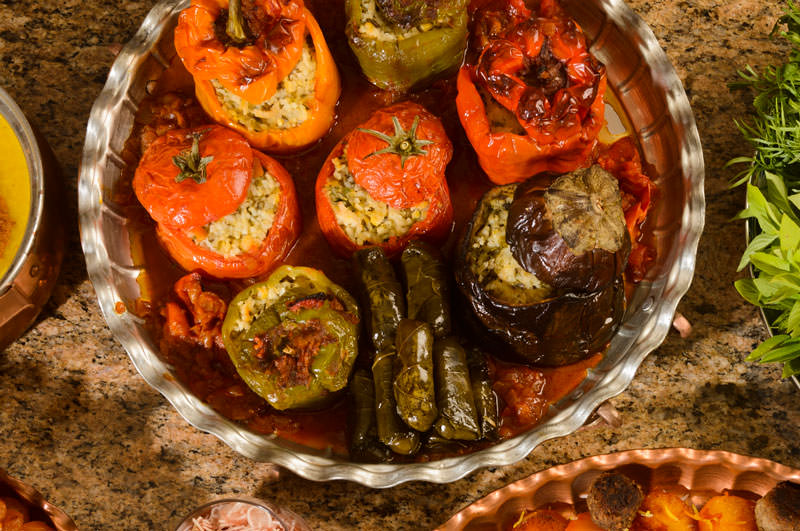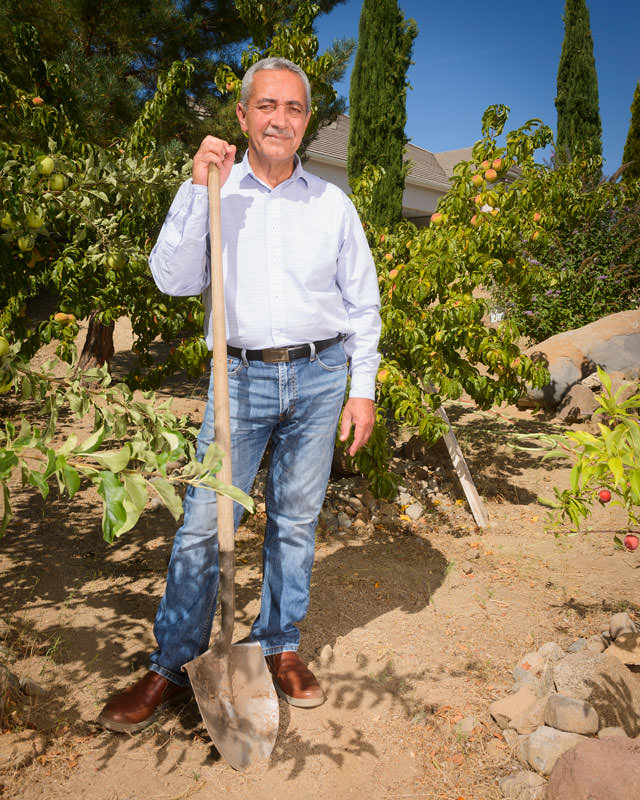Reno backyard is an edible wonderland.
Wandering through Ali Sar-Sangi’s 0.76 acres of delectable growth in Southwest Reno is like exploring an edible wonderland — a verdant, delectable Garden of Eden in which you’re transported to faraway lands amid the growth, much of which is foreign to this region.
“Try this. It’s called tare,” Sar-Sangi says, plucking a thin green stalk from a plant. Its flavor is distinctive, far more pungent than the green onions you find in grocery stores.
The inspiration behind his garden?
His homeland, along with a bottomless passion for food and community.
A Taste of Home
Born and raised in Tehran, Iran, Sar-Sangi discovered his fervor for gardening as a child. With little available land, his hometown’s prevalent flat rooftops served as residential growing grounds. Dishes he enjoyed in his youth were made from the fruits of the family’s rooftop cultivation and often were sourced from a family cookbook called Food of Life by Najmieh Batmanglij — a tome that remains his primary culinary resource to this day.
It serves as a guide in turning Sar-Sangi’s bounty of produce and herbs into fragrant, mouthwatering meals for his wife of 18 years, Faranak, and their three children.
Sar-Sangi explored cooking in the ’70s while in the United States on a student visa studying mechanical engineering. Cooking provided him with a connection to his home while residing in a country teeming with pizza and burgers.
Attending the University of Nevada, Reno, he would go to school on weekdays and work in restaurants on the weekends. He aspired to have a restaurant of his own one day — a dream that came to fruition years later when he opened Bailey’s Café in Reno.
After 15 years as a restaurateur, he decided to relinquish his role and spent seven years working in the front of the house at Sterling’s Seafood Steakhouse in the Silver Legacy Resort Casino. After a family illness called him home to Iran for about a year, he returned to the U.S. and took a position at the Atlantis Casino Resort Spa in Reno, where he worked his way up to his current role, fine dining manager.
Plant-iful Success
Over the course of 20 years, Sar-Sangi had imagined his dream garden. He eventually found the property where his family now resides and was able to bring his botanical vision to life.
“When you love the plants, they love you back,” Sar-Sangi says, explaining how items such as pistachios, pomegranates, and golden quince thrive in his garden.
His inspirations are his homeland and his desire to grow an exceptional quality of product.
“What I grow tastes so much better than what’s in the stores,” he says.
Many of his plants and trees are each grown from a single stem — inspected thoroughly for diseases and pests by the U.S. Department of Agriculture before release — which he transports from Iran.
These often are grafted with trees and plants proven to thrive in Northern Nevada’s high-desert environs. Sar-Sangi says that for the first few years, he has to baby these new transplants by blanketing them during cold snaps until they acclimate. Within about three years, they learn to survive on their own.
Each year’s bounty usually includes apricots from different areas, including Iran, as well as sour cherries, pears, figs, peaches, persimmons, walnuts, and various grapes. Vibrant eggplants, zucchini, tomatoes, and cucumbers peek out from behind flourishing leaves.
Seemingly blissful herbs such as fenugreek, cilantro, parsley, dill, and basil reach for the skies from the ground and pots. The tare he shared is an Iranian varietal grown from seed. Even his roses and hibiscus are used in edible or drinkable concoctions such as teas.
“Once you have that love and passion for the food, you start coming up with ideas,” he says.
No Leftovers
With the plentiful produce his garden generates annually, there is one thing Sar-Sangi is proud to say it doesn’t produce at all: waste.
How is that possible?
While dishes created from his experience and family cookbook, such as dolmas, a Persian fresh herb stew called Khoresh-e Ghormeh Sabzi, and jeweled rice, put the fruits of his labors to good use, he also finds other ways to use the leftovers.
Items such as apricots and peaches are used in dishes, then made into jams, desserts, and fruit leathers. Pears are poached in cardamom, cinnamon, and saffron. Grapes are sundried into candy-sweet raisins. Herbs are sautéed, then frozen to create a flavorful winter supply. Even seeds are cracked and toasted for consumption.
“There is zero waste, none whatsoever,” Sar-Sangi says. “Everything I grow, there’s a reason behind it.”
Annually, guests of the Atlantis look forward to celebrating his culture’s flavors also. A multi-course Persian dinner largely comprised of items from Sar-Sangi’s garden is prepared by the property’s chefs, then paired with wines and enjoyed at the usually sold-out feasts.
Friends and family also revel in Persian cuisine sourced from his land. Roaming critters aren’t dissuaded from indulging as well.
“I let them take what they want. I share,” he says, smiling.
Anything remaining is cooked or provided to people in need in the community.
He says his garden has never looked better than after he was out of work for a couple of months during the COVID-19 outbreak. With the extra time spent at home, he was able to start early and tend to them like never before.
An added benefit of being homebound? Bonding more than ever with his family over his carefully cultivated dishes.
Freelance writer Natasha Bourlin is a longtime fan of Persian cuisine and was inspired by Sar-Sangi’s enthusiasm, kindness, and talents.
Stuffed Green Peppers, Eggplants, and Tomatoes
(recipe from Food of Life by Najmieh Batmanglij, used with permission from Mage Publishers. Serves 4)

4 large tomatoes
2 green bell peppers
2 eggplants
¼ cup rice
¼ cup yellow split peas
7 to 8 tablespoons oil, divided
1 onion, finely chopped
1 pound ground beef, lamb, or veal
2 tablespoons tomato paste, divided
¼ cup parsley, chopped
1 tablespoon mint, chopped
1 tablespoon tarragon, chopped
1 tablespoon scallion, chopped
2¼ teaspoons salt, divided
¼ teaspoon freshly ground pepper
1 teaspoon cinnamon
⅓ cup vinegar or lemon juice
⅓ cup sugar
Preheat oven to 350 degrees F. Wash tomatoes, green peppers, and eggplants.
Remove stems from eggplants, slice off their tops, remove caps, and set aside. Slice off the bottoms so the eggplants can stand on their own. Hollow out using the point of a knife and a teaspoon, and discard flesh. Sprinkle insides of shells with 1 tablespoon salt and place in colander to drain for 20 minutes. (This removes bitterness of eggplant skin.)
Cut off tops of green peppers, about ½ inch from stem, and set caps aside. Blanch peppers for 5 minutes in boiling water. Rinse with cold water and drain.
Remove stems from tomatoes. Slice off caps and set them aside. With a teaspoon, remove tomato pulp and reserve.
Cook rice and split peas together for 20 minutes in 2 cups of water and ¼ teaspoon salt. Drain.
Rinse eggplants and pat dry. Heat 3 tablespoons oil in skillet and brown eggplants on all sides, adding more if necessary. Set aside.
Brown onion and meat in 2 tablespoons oil. Stir in 1 tablespoon tomato paste.
In large bowl, combine meat, rice-and-split-pea mixture, and chopped herbs. Season with 1 teaspoon salt and ¼ teaspoon pepper. Mix thoroughly.
Fill tomatoes, green peppers, and eggplants with stuffing. Replace caps.
Place stuffed peppers and eggplants side by side in ovenproof dish, leaving room for the tomatoes, which do not need to cook as long. Mix 1 tablespoon tomato paste into 2 cups water or broth, and pour around stuffed vegetables. Cover and bake 45 minutes.
Combine tomato pulp, cinnamon, 2 tablespoons oil, lemon juice, and sugar. Mix well.
Remove the dish from the oven and add stuffed tomatoes. Pour the tomato-pulp mixture around stuffed vegetables, cover, and return to oven. Bake 35 minutes longer or more.
When vegetables are done, taste sauce, and add more seasoning if desired. Serve in baking dish or arrange on a platter. Serve with bread and yogurt.


